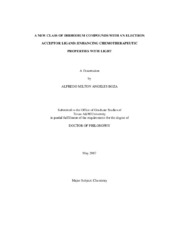| dc.description.abstract | The syntheses and characterization of new dirhodium complexes based on the electron acceptor ligand dipyrido[3,2-a:2´,3´-c]phenazine (dppz) and its derivatives are reported. These complexes have been shown to photocleave pUC18 plasmid in vitro under irradiation with visible light which results in the nicked, circular form of DNA. Unlike typical DNA photocleavage agents, the new compounds are capable of photocleaving DNA in the absence of oxygen as well as in the presence of oxygen. The toxicity of the complexes which contain the electron acceptor dppz ligand toward human skin cells increases when the cell cultures are irradiated with visible light. In contrast, the photocytotoxicity of those complexes that do not contain the dppz do not differ from cytotoxicity in the dark. The chemistry of the newly synthesized dirhodium-dppz complexes with glutathione, which is considered to be an important molecule in the deactivation of metal-based drugs, has also been investigated. The results show that glutathione reversibly reduces [Rh2(µ-O2CCH3)2(dppz)2]2+ (6) and [Rh2(µ-O2CCH3)2(dppz)(bpy)]2+ (7), and that they are easily reoxidized to the original form in air. EPR measurements and DFT calculations indicate that the additional electron is delocalized in the ligand orbitals. The molecular characteristics that affect the in vitro activity of dirhodium complexes is discussed. The lability of the groups coordinated to the dirhodium complexes is a significant factor that influences the toxicity of the complexes. In addition, the presence of labile solvent molecules and monodentate acetate groups provide potential “open sites” accessible for nucleophilic substitution, as opposed to these sites being occupied by non-labile groups that reduce the reactivity of the complexes. Finally, the results also demonstrate that the carbonato-bridged complexes of the type [Rh2(µ-O2CO)2(diimine)2(H2O)2]2+ are useful precursors to access new dirhodium-diimine compounds that are not accessible from the acetate precursors. These compounds react with trifluoroacetamide, 2-pyrrolidinone, and trifluoroacetic acid to form products in which the carbonato ligands are substituted in favor of the new bridging group. This work provides a foundation for the preparation of new series of dirhodium complexes that contain the dppz ligand and bridging ligands other than acetate. | en |


